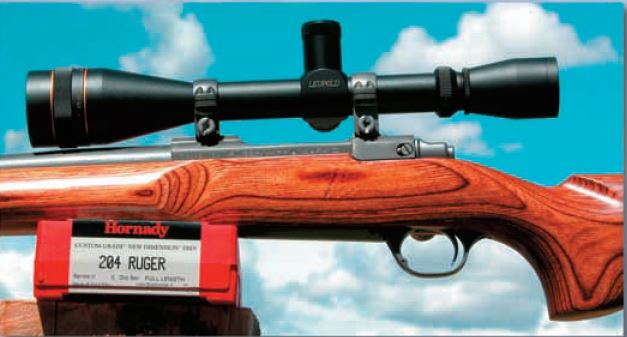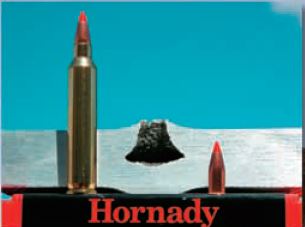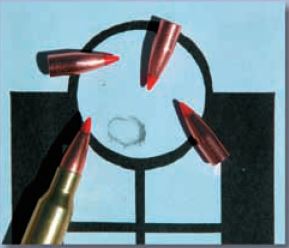
Speed without accuracy is of little use to a varmint or predator hunter aiming at beer bottle-sized targets at 300+ yards. Not to worry. Factory .204 ammo averaged right around 0.64” at 100 yards. My best handloads were just a little slower at 4,184 fps, but averaged just 0.21” at the same distance. Fast and accurate? Ruger and Hornady have hit a home run for varmint hunters with the new .204 for sure!
In the U.S., varmint hunters buy lots of guns, ammunition, and also buy and load even more bullets, burning up dozens of cans of powder and thousands of primers each year. Gun makers sell more varmint guns than most any other caliber type of rifle each year. By far the most popular diameter bullet in the U.S., is the humble .22 caliber. For decades, we have had the hot .220 Swift, the popular .22-250, and of course the .223 Remington. While the Swift had held the title of velocity king, the more sedate and popular .223 has a lot going for it.
When you have hundreds of rounds to shoot in a day (or over a thousand), the bigger cartridges may offer more reach, but this comes at a great cost. Increased recoil often results in not being able to call your shots. The barrel can quickly get so hot that you can burn out the throat. Though the .17 Remington was offered up around 40 years ago, the light bullet with a low ballistic coefficient and very tiny bore did not fare well at ranges past 200 yards. Stuck on the .22 caliber, the only way to get more reach was to burn more powder. Was there a better way?
Chapter 1: A Need for Speed
Click for LOAD DATA SHEET
Ruger teamed up with Hornady to look at a middle-of-the-road .204 caliber that betters the speed of the .17, but with a more effective bullet weight. Factory loaded in 32 and 40-gr weights, the impact on game is incredible to see. As a non-scientific test, I smacked a 20 lb. block of pottery clay up close (much too close!) with the factory 32-gr bullet.
The block measured 8 x 8” on its end and was 16” long. Fully expecting to have a grapefruit-sized cavity result, I thought it would look good to section the fired block to
visually demonstrate the effects of very high velocity on a somewhat fluid material. Was I ever surprised when the entire front half of the block just disappeared at the shot! I...
was plastered all over with chunks of clay that smacked me with some force! The resultant “cavity” immediately reminded me of the ending of Terminator 2 when the liquid-metal robot took a grenade to the chest! Bits and pieces of lead and jacket are scattered throughout the clay, indicating that the bullet disintegration was very complete.
Always the experimenter, and at a much safer distance, I next shot a ¾” thick section of aluminum to see the effects of tremendous speed on metal. At the shot, the disc just fell over. As I picked it up, I noticed the “mud” crater-like impact swell on the surface. Turning it over, I saw and felt how the metal had been displaced out from the great force. Returning to my shot, I sectioned the disc and was amazed at the “bell cone” of material that had been displaced by the great speed! A lot was sure going on in that aluminum. If you look closely at the outer edge of the crater, you can see the fracture lines where a “plug” was beginning to shear and blow out of the back. While not really scientific, and something I had never done before, I’m glad I tried. It sure does make for interesting photos!
Does this great speed and power mean that barrels will get burned out in short order? Not to worry. Hornady has put over 2,000 rounds through test barrels, and they
still exhibit little wear and give great accuracy.
There was no appreciable velocity difference between the rifles, as they both had 26” barrels.
Based on an improved version of the once offered .222 Remington Magnum, the shoulder has been moved forward and the taper decreased in order to increase the case
capacity over the popular .223 Remington by around 4 grains of water. With top loads for the lighter bullet using only around 30-grs of powder, it achieves better than Swift
velocities while burning around 30% less powder. So it will be far kinder to barrels. Lower recoil also makes for being able to regularly spot your hits (or call your misses) way out yonder, far easier than larger .22s or the 6mms.
Chapter 2: The Ruger Offerings
Right out of the gate, Ruger offered the .204 in five different versions, helping to appeal to most every shooter with two Number 1s and three bolt action versions. The single shot can be had in a blued walnut stocked sporter weight (as shown), or a heavy barreled stainless...
laminate version (both with 26” barrels). Bolt action models include the tested M-77 Target stainless laminated model (26”) as tested here, a blued walnut sporter (24”) or an All-Weather Ultra Light carrying a synthetic stock and light 20” barrel.

The single shot sporter (0.620” muzzle diameter) and the heavy laminated target model (0.740” muzzle diameter) were tested for this report. The Number 1 averaged just less than 0.79” at 100 yards with either the 32 or 40-gr loads. The 77 target bolt action shot around 0.63” with the lighter bullet, and 0.79” with the heavier 40-gr slug. Note that sometimes groups half that size would result.
There was no appreciable velocity difference between the rifles as they both had 26” barrels. All load development was done with the heavy barreled target model. It was great to shoot since it has a two-stage trigger that breaks cleanly at less than 3 lbs. On both rifles, I mounted a Leupold Vari-X II 6-18 power target scope. Its excellent optics allowed me to see clearly, and helped me shoot so many tiny groups.
Chapter 3: Reloading the .204
Hornady dies were used for reloading as were their 32 and 40-gr bullets. As all new brass was going into making ammunition, I used the factory cases for reloading after first testing it for accuracy. Primer pockets remained tight even after 4 or 5 loadings. Federal 205M match small rifle primers were used for all loads. The MTM brand powder funnel kit I had on hand worked well for charging the cases with the .22 caliber funnel adapter installed. Other brands may not work as well, so check first before a lot of powder gets spilled all over.
There is nothing like the thrill of great speed on a race track… or in the fields of green that face the varmint hunter.
As you look over the loading data, it is obvious that the .204 Ruger is a very accurate cartridge. How impressive to see that the nine handloads I tested averaged under one-half inch for 3-shot groups! All powers tested performed quite well, with Hodgdon H4895 doing wonders with the 32-gr V-Max bullet. Three-shot groups averaging 0.25 at almost factory...
velocities is very impressive performance for sure- with a ‘best group’ size of only 0.20”!

Time did not permit handloading for the 40-gr V-Max bullet, which is a boat tail design, and boasts a ballistic coefficient that matches the .22 caliber Hornady 55-gr V-Max bullet. At around 3,800 fps, it actually shoots flatter at extended ranges than the faster 32-gr bullet due to an almost 25% increase in its BC (.255 vs. the 32-gr BC of .205). To boost the 55-gr/.22 bullet to the same speed would require a much larger cartridge, burning much more powder than the .204 Ruger with far more blast and recoil, and faster barrel heat-up.
This is where the niche exists for the .204, an adequate bullet weight for the task at a much higher speed than most all .22s. During field testing, many prairie dogs were shot out to 250+ yards using the faster 32-gr V-Max. It is an extremely effective varminting bullet. Even fringe hits caused instant and humane results. I believe for larger animals like coyotes, the 40-gr V-Max might be better suited, especially at longer distances.
Chapter 4: Summary
While it may seem like gun manufacturers may struggle at times to come up with something really different to offer the shooting public, it is really hard to come up with something truly new and unique. Ruger and Hornady have succeeded very well, in my opinion, with the .204 Ruger.
It eliminates the accuracy and fouling problems that have always plagued the .17 calibers, exceeds the top speeds of the really large .22 cases, while still offering adequate bullet weight to get the job done. Hornady has come up with two new high BC bullets for the .204 that are very accurate and perform their tasks quite well. The accuracy of the .204 makes me want to shoot it again and again, on paper and in the field. There is nothing like the thrill of great speed on a race track, or in the fields of green that face the varmint hunter.